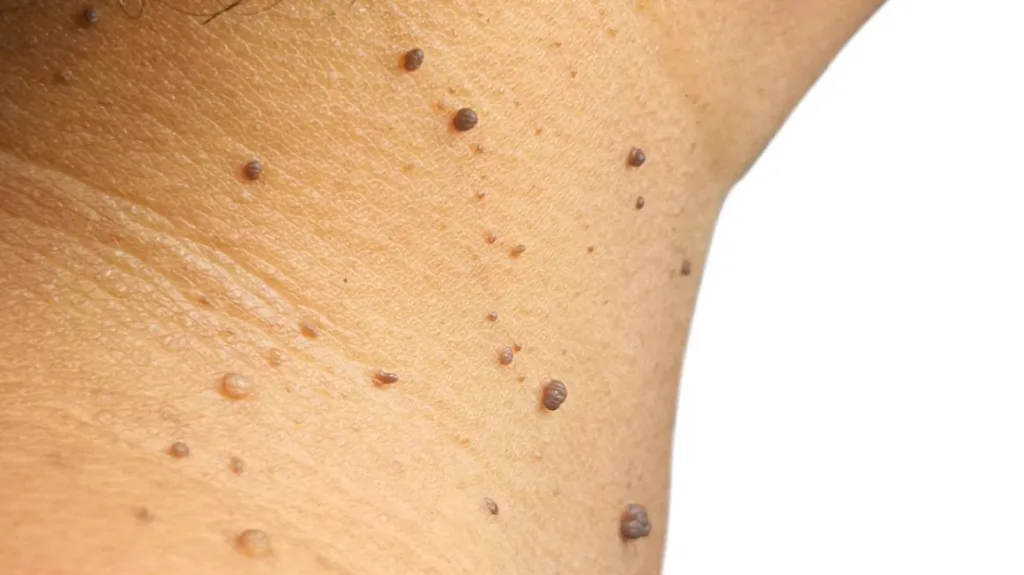Warts are a common skin condition caused by the human papillomavirus (HPV). They can appear on any part of the body, but are most commonly found on the hands, feet, and face. Warts can be unsightly, and in some cases, painful. One common characteristic of many warts is the presence of black dots or specks within them.
These black dots are not actually seeds, as they may appear to be. Rather, they are small blood vessels that have grown into the wart to supply it with nutrients and oxygen. As the wart grows larger, it can caue more blood vessels to form, leading to an increase in the number of black dots.
So why do warts turn black? The black color is due to the presence of dried blood within the wart. When the blood vessels within the wart are disrupted, either by injury or treatment, blood can leak out and become trapped within the wart. Over time, this blood will dry out and turn black, giving the wart its characteristic appearance.
While the presence of black dots within a wart is not necessarily a cause for concern, it is important to seek medical attention if you have a wart that is painful, bleeding, or growing rapidly. Your doctor may recommend treatment options such as cryotherapy (freezing), laser therapy, or surgical removal.
In some cases, over-the-counter wart removal medications containing salicylic acid may be effective at removing warts. These medications work by gradually dissolving the wart tissue, causing it to peel away over time. As the wart tissue is destroyed, the blood vessels within the wart may be disrupted, leading to the formation of black dots.
The presence of black dots within a wart is a common characteristic of many types of warts. These black dots are actually small blood vessels that have grown into the wart to supply it with nutrients and oxygen. While not a cause for concern in most cases, it is important to seek medical attention if you have a wart that is painful, bleeding, or growing rapidly. Treatment options are available to help remove warts and prevent them from spreading to other areas of the body.
Why Do Warts Go Black?
Warts can turn black due to a variety of reasons. One of the most common reasons is the death of the tissue within the wart. This can occur due to a lack of blood supply to the area or due to the body’s immune system attacking the wart. As the tissue dies, it can turn black and may eventually fall off. Another reason for warts turning black is the presence of blood vessels within the wart. These blood vessels can sometimes burst, causing the wart to turn black. Additionally, some treatments for warts, such as freezing or burning, can case the wart to turn black as the tissue is damaged. warts can turn black due to tissue death, burst blood vessels, or as a result of treatment.

Does Black Warts Go Away?
Black warts, also known as plantar warts, may go away on their own over time as the immune system fights off the virus. However, in some cases, they may persist for years or even spread to othr areas of the foot. It is recommended to seek medical attention if the wart is painful, bleeding, or interfering with daily activities. Treatment options may include over-the-counter topical medications containing salicylic acid, cryotherapy (freezing the wart with liquid nitrogen), or surgical removal. It is important to note that even with treatment, the virus that causes warts may still be present in the body and warts may recur.
What Color Does A Wart Turn When Its Dying?
When a wart is dying, it typically turns white. This is because the acid used to treat the wart causes the infected skin cells to die and turn into dead tissue. As a result, the wart will no longer have a blood supply, and the skin around it may also turn white. It is important to note that not all warts respond to acid treatment in the same way, and some may require multiple treatments before they begin to die and turn white. Additionally, it is alays advisable to consult a medical professional before attempting to treat a wart at home to ensure proper treatment and avoid any complications.
Why Did My Wart Turn Black After Treatment?
After wart treatment, it is common for the wart to turn black. This is because the treatment causes the blood vessels feeding the wart to clot, leading to a lack of blood supply to the wart. As a result, the affected skin cells will begin to die, and the wart will turn black. This is a sign that the treatment is working, and the wart will eventually fall off as the dead tissue sloughs off. It is essential to note that this is a normal and expected part of the healing process and should not be a case for concern.
Conclusion
The black dots that appear in some warts are atually visible blood vessels that are supplying the wart with nutrients and oxygen. While warts can often go away on their own, it may be necessary to seek treatment if they are causing pain, spreading or are unsightly. Over-the-counter wart removal medications containing salicylic acid can be effective in turning the wart into dead skin, which may result in a small amount of bleeding and eventually turn the blister dark purple or black. This is a normal part of the healing process and should not be cause for concern. As always, it is important to consult with a healthcare professional if you have concerns about the appearance or treatment of warts.
